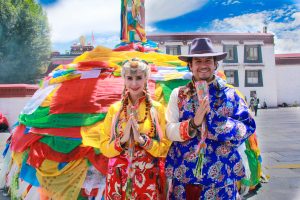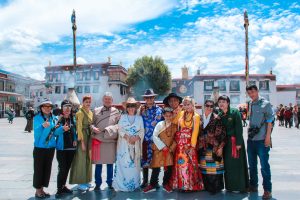I met her in a sunlit room in Shigatse. She lay folded on a wooden bench, not old, but holding the weight of countless mornings. She was a “chuba”, the traditional Tibetan robe, and for the next week, she would be my guide and my garment on the high plateau.
The first time I put her on, the world shifted. The thick wool was heavy, a substantial weight around my shoulders. I wrapped the right side over the left, as is custom, and used the long sash to tie it all in place. It felt awkward at first, like wearing a tapestry. But then I stepped outside into Lhasa’s crisp air, and her logic became clear. The robe was its own ecosystem. With the sash tight, she trapped my body heat, a warm embrace against the mountain wind. When the sun grew strong, I could loosen the top, or even shed one sleeve to cool down, letting my right arm swing free like the local men I saw walking Barkhor Street.

We walked together around the Jokhang Temple, and there, among the swirling pilgrims, she became my camouflage. I was no longer just a spectator. The rhythmic “swish” of her woolen skirt against my boots matched the sound of the pilgrims’ own robes. The bright, striped patterns of her fabric—blues like Yamdrok Lake, reds like monastic walls—felt like a part of the moving tapestry. I felt the glances of other Tibetans, not of curiosity, but of quiet recognition. My presence in the robe was a small, silent nod of respect.
One afternoon, a gust of wind sent a flurry of prayer flags dancing and caught the wide sleeve of my “chuba”, making it billow like a sail. In that moment, I wasn’t wearing a costume; I was participating in the landscape. The robe felt ancient and practical, a perfect design forged by wind, sun, and faith. It was armor against the elements and a uniform for the soul.
Sitting in a teahouse later, I spilled a drop of butter tea on her sleeve. Instead of annoyance, I felt a strange sense of completion. The dark stain joined the faint scent of smoke and earth already woven into the fibers. She was no longer new; she was being lived in.

When the journey ended, I folded her carefully and placed her back in my suitcase. The weight was familiar now, a comforting presence. The “chuba” was more than clothing; she was a teacher. She taught me that to truly know a place, you must sometimes change your skin, or at least your cloth. She taught me that warmth is not just a physical state, but a feeling of belonging, stitched together with threads of wool, wind, and wonder. Back home, I sometimes open my closet and touch her rough texture, and the memory of that high, bright world rushes back, a whisper from the Roof of the World.
Leave a Reply